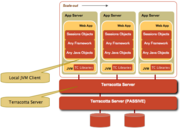欢迎大家赞助一杯啤酒🍺 我们准备了下酒菜:Formal mathematics/Isabelle/ML, Formal verification/Coq/ACL2/Agda, C++/Lisp/Haskell
Terracotta
来自开放百科 - 灰狐
(版本间的差异)
小 (→Links) |
|||
| (未显示1个用户的3个中间版本) | |||
| 第1行: | 第1行: | ||
| − | {{SeeWikipedia}} | + | {{top news}} |
| + | {{SeeWikipedia|Terracotta Cluster}} | ||
Open Source Clustering For Java | Open Source Clustering For Java | ||
| 第23行: | 第24行: | ||
==Links== | ==Links== | ||
*http://www.terracotta.org/ | *http://www.terracotta.org/ | ||
| − | |||
*http://docs.huihoo.com/terracotta | *http://docs.huihoo.com/terracotta | ||
[[Category:Cluster]] | [[Category:Cluster]] | ||
[[Category:Java]] | [[Category:Java]] | ||
| + | [[category:event]] | ||
2013年1月4日 (五) 02:58的最后版本
| |
您可以在Wikipedia上了解到此条目的英文信息 Terracotta Thanks, Wikipedia. |
Open Source Clustering For Java
目录 |
[编辑] JVM Level Clustering
- Heap-Level Replication: Selectively share object graphs across the cluster
- Large Virtual Heap: manage heaps that are much bigger than what can be contained in a single JVM.
- Cluster Wide Locking Semantics: distributed wait/notify and synchronized
- Runtime Monitoring and Control: View in real-time objects in the heap
- Fine-Grained Changes: Terracotta does not use serialization, and therefore can push field-level changes to the cluster. This translates into better network efficiency for replication.
- No Serialization: Because Terracotta clusters at the JVM level, no serialization code is required.
[编辑] Other Projects
[编辑] Used
- HTTP Session Clustering
- Distributed Caches
- Cluster OSS Frameworks
- Distributed Workload
- Cluster Spring, Webflow & Events
- Cluster any Java POJO
[编辑] Reference
[编辑] Links
分享您的观点
